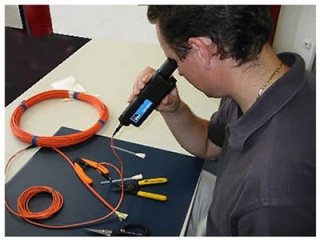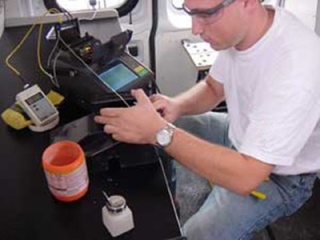Marketing
Be Careful When Working With Fiber Optic Cable
Itís known that safety issues or hazards are commonplace in both copper and fiber cabling installation, faced by installers. And when it comes to this topic, many people think that copper cabling installation need more attention and caution, since they carry electricity. In comparison, optical fibers are safer because of the light they carry. But actually, this concept is misplaced. As to fiber optic cables, whose ends are capped with the same or different connectors (e.g. ST ST fiber cable and LC to SC cable), they carry data in the form of light which can bring harms to the eyes.
Many people are unaware of the problems that fiber poses. Some installers donít think much of fiber optic issues, and they donít take proper safety precautions to avoid the many hazards that can be caused by fiber optics. Working with fiber optic cables needs much caution, and installers need to do the two points for safety: fiber fragment disposal and eye protection.
Fiber Fragment Disposal
When an installer is trimming, stripping, or cutting fibers, tiny fragments may fall where it will--on the top of the table where the job is being done, at the bottom of the raised floor, or maybe into a cup of coffee that is close by. The scraps may even be brushed into a nearby garbage can. Then what happens if someone rests his or her hand on top of that fiber scrap? The glass is transparent and the scrap is probably small, so unless the person is the one who did the terminating, he or she may not know the hazard is there. Because of this, workers should not eat or drink in a fiber optic work area since a fiber scrap could fall onto their food or in their drink.
Itís important to keep in mind that tiny fiber fragments can penetrate the skin and become embedded, causing a serious irritation. Ingested fibers can cause internal damage since they are light enough to float in air.
To avoid such potential danger, these safety kits can be used:safety glasses (for keeping eyes free of scraps), a black polishing/work mat (the black surface makes it easier to locate fiber scraps), Teflon-coated tweezers to remove splinters (regular tweezer ends break fiber scraps), and a bifurcated swipe (for cleaning fiber ends and sterilizing the tweezers for splinter removal). One of the most popular components of the kit is the fiber-scrap trash can, which provides a single place for disposing of bits of fiber. Once full, the small trash can may be incinerated.
Eye Protection
After finishing cable installation, many installers unfamiliar with fiber-optic technology may look at the fiberís end to verify that light is being transmitted, which causes the loss of visual acuity or blind spots because the beam is focused on the retina. Whatís even worse is that the light used in fiber- optic communications systems is in the infrared range and is not visible to the human eye.
So when working with fiber optics, all workers performing any splicing or termination activities should always wear safety glasses with side shields. Any other people or site managers entering the work area should wear safety glasses with side shields also. Unless an installer is absolutely sure there is not a light source at the other end, they should never look directly into the end of the cable. A power meter can be used to make certain the fiber is dark.
Other Safety Considerations
Chemicals: Fiber optic splicing and termination use various chemical cleaners and adhesives as part of the processes. Normal handling procedures for these substances should be observed. Even simple isopropyl alcohol, used as a cleaner, is flammable and should be handled carefully. Manufacturers will supply "material safety data sheets" (MSDS) on request or they may be found on the Internet.
Splicing hazards: Fusion splicers use an electric arc to make splices, so care must be taken to insure no flammable gasses are present in the space where fusion splicing is done.
No Smoking: Smoking should also not be allowed around fiber optic work. The ashes from smoking contribute to the dirt problems with fibers, in addition to the possible presence of combustible substances (and, of course, the health risks.)
Safety Tips
While working with fiber optics, the worker needs a well-ventilated and well-lit work area. Workers must avoid smoking while working with fiber optics.
Also, all food and beverages should be kept out of the work area. Workers can wear disposable aprons to keep fiber particles off their clothing. Before leaving the work area, an employee should always check their clothing for pieces of stray fiber, and if any are found, they can remove it with double-sided tape.
A worker should wash their hands thoroughly before touching their eyes, and contact lens wearers should wash their hands before touching their lenses. Workers should also read all instructional material before handling chemicals.
A disposable container that can be tightly closed must be used for fiber scraps. When finished with a fiber optic job, all cut fiber pieces should be disposed of properly along with any used chemicals and containers. The work area should be thoroughly cleaned when job is completed.
Conclusion
Understanding the potential dangers and knowing the simple fiber optic safety tips can keep the working environment clean and safe for workers, so as to avoid hazards. As an outstanding fiber patch cord manufacturer, Fiberstore supplies various kinds of fiber optic cables for your cabling installation, test- and quality-assured. You can have a try here.
Post je objavljen 20.07.2016. u 05:38 sati.


